Yes, the new MS should have more HF dispersion. The current A5.2 is really the 1st iteration of the MS drivers, just that with its small size it does not require the more radical cure as in the A7/11ms. And prudence had them using the old-style basket. The new baskets require significant upfront tooling costs.
dave
dave
No doubt the bean counters’ analysis of sales volumes per size / model type have as much - or more - to do with when any new engineering department design evolution can be implemented/ amortized. In some small businesses that’s really two corners on the same hat.
Considering that at least one of Mark’s commercial products uses close to a version of the A11 & 5.2 - with no doubt some specific “tweaks” - in two way configurations with which Scott is familiar, I’d say the new little guy does a fair job as wide band mid-tweeter
Considering that at least one of Mark’s commercial products uses close to a version of the A11 & 5.2 - with no doubt some specific “tweaks” - in two way configurations with which Scott is familiar, I’d say the new little guy does a fair job as wide band mid-tweeter
After having my A11MS running for a few weeks now, I am continually impressed with their effortless, detailed, extended & beautifully smooth sound quality, the midrange/vocal region in particular is just sublime (for my taste anyway).
I can’t help wondering what Mark Fenlon would be capable of producing if he developed a driver dedicated to Mid/high only, freed from the need to produce bass & the Xmax associated, surely more focus could be applied to aspects like wider dispersion?
I am currently crossing over to my bass cabinets at 200hz, even at very high levels with electronic dance music, the cones are probably moving less than 1mm.
This may be a bit of a personal wish, but with the popularity of woofer assisted wideband, availability of dsp & like myself, sub sat systems with wideband bass cabs that are able to cross at 300-500hz, surely a mid/high driver would be very popular ?
There's very little that you can do to a driver to change it's beamwidth. For the most part, a 3" woofer from one company will have a beamwidth that's virtually identical to a 3" woofer from another company.
Making the driver larger WILL alter it's beamwidth; basically all radiators begin to beam when the wavelengths are smaller than the radiator. For instance, a 6" woofer with cone that's about 5" in diameter will begin to beam at 2700hz. (speed of sound / diameter)
If you find that your loudspeaker doesn't have enough beamwidth, the easiest way to increase the beamwidth is to simply reduce it in size. For instance, a 1" radiator won't beam until 13,500khz.
The best solution to achieve a targeted bandwidth is to load a small radiator on a waveguide. The second best solution is to use an array of radiators, combined with physical or electronic wavefront shaping, or both.
Patrick,
The extention of a FR driver on the top end has a lot to do with its shape and how it "breaks up”. Ideally more & more of the outer portion of the cone reduces its output and the cone effectively becomes smaller at higher frequencies.
The generalization that all woofers will have the same HF performance comes from their initial modeling as flat disks.
dave
The extention of a FR driver on the top end has a lot to do with its shape and how it "breaks up”. Ideally more & more of the outer portion of the cone reduces its output and the cone effectively becomes smaller at higher frequencies.
The generalization that all woofers will have the same HF performance comes from their initial modeling as flat disks.
dave
I think PB's post might have been meant for a different thread?
Be that as it may, the bald maths is correct as far as it goes (i.e. as Dave points out, an assumption of a flat piston) but in practice things get a mite more subtle, especially with wideband drivers where you are not necessarily (rarely) dealing with piston behaviour or a single radiating surface, but multiple radiators or resonant surfaces which may have significantly different profiles. For e.g. you can have a rather shallow cone profile that possesses significantly less HF beaming than a driver of identical diameter but with a steeper cone profile. And if you then combine that with, say, a central tweeter dome that is direct-coupled to the VC and functions as an HF sub-radiator, you suddenly get into a rather different set of conditions. Whizzers perform similar duties of course. And that's before we start to get to some of the more 'interesting' cone profiles e.g. the recent MS series units from MA, which have a negative camber cone profile, i.e. the periphery of the cone actually bends backward before terminiating into the surround, further enhancing off-axis radiation. And so on & so forth. Interesting topic.
Be that as it may, the bald maths is correct as far as it goes (i.e. as Dave points out, an assumption of a flat piston) but in practice things get a mite more subtle, especially with wideband drivers where you are not necessarily (rarely) dealing with piston behaviour or a single radiating surface, but multiple radiators or resonant surfaces which may have significantly different profiles. For e.g. you can have a rather shallow cone profile that possesses significantly less HF beaming than a driver of identical diameter but with a steeper cone profile. And if you then combine that with, say, a central tweeter dome that is direct-coupled to the VC and functions as an HF sub-radiator, you suddenly get into a rather different set of conditions. Whizzers perform similar duties of course. And that's before we start to get to some of the more 'interesting' cone profiles e.g. the recent MS series units from MA, which have a negative camber cone profile, i.e. the periphery of the cone actually bends backward before terminiating into the surround, further enhancing off-axis radiation. And so on & so forth. Interesting topic.
Patrick,
The extention of a FR driver on the top end has a lot to do with its shape and how it "breaks up”. Ideally more & more of the outer portion of the cone reduces its output and the cone effectively becomes smaller at higher frequencies.
The generalization that all woofers will have the same HF performance comes from their initial modeling as flat disks.
dave
A radiator will begin to beam when the wavelengths are shorter than the radiator. For instance, we'd expect a 4" radiator to begin beaming at 3,125hz.
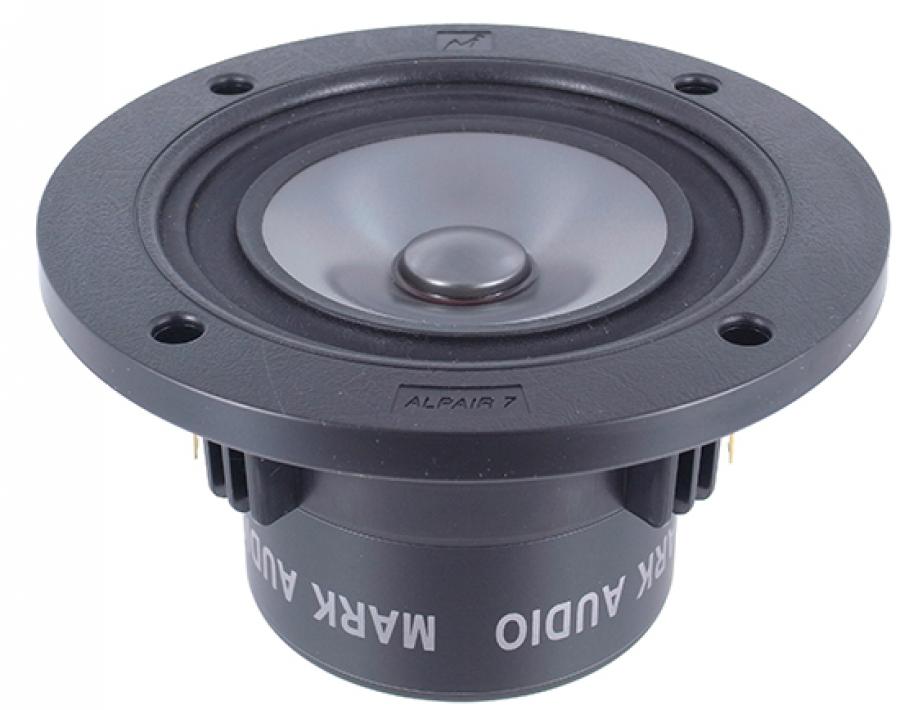
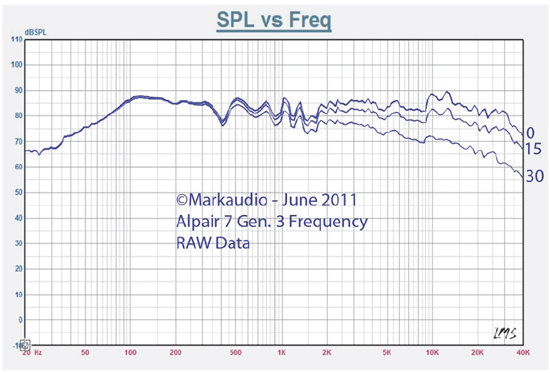
Here's an Alpair 7. 5" frame and 4" cone, it begins to beam around 3khz. Cost is $85.
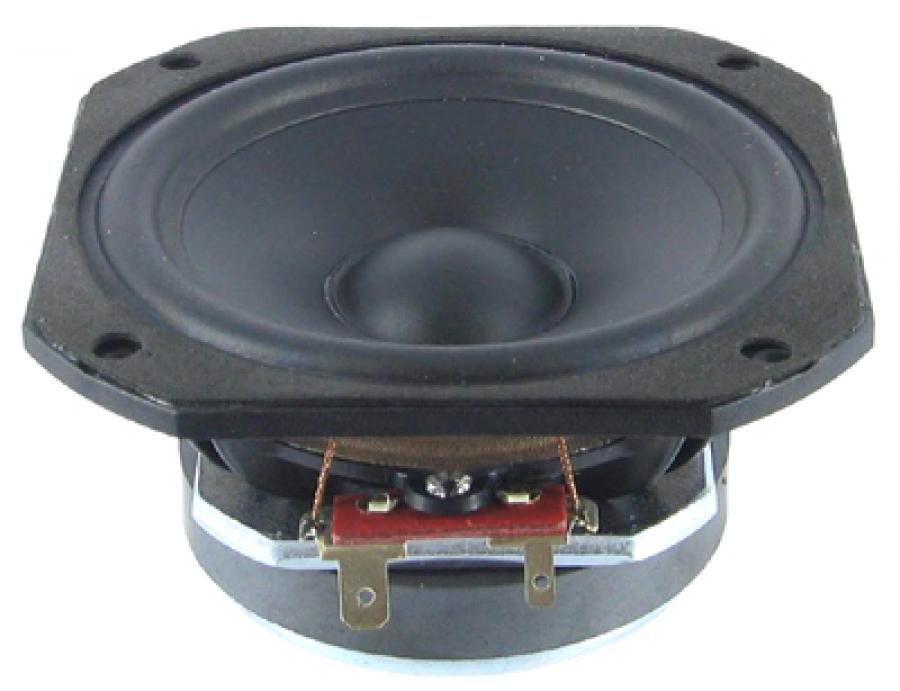
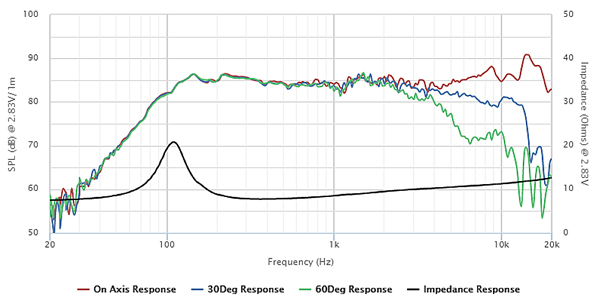
Here's a Tymphany TC9. 3.5" frame and 3" cone, we'd expect it to start beaming at 4500Hz, which it does. The cost is nine dollars.
Now, the Alpair clearly looks much better on that graph, NO DOUBT.
Except for two little things...
First off, Tymphany is using a 50dB scale on their graph. Mark Audio is using a 120dB scale, which c'mon, is just ridiculous. By using a scale that's more than double the industry standard, it masks the severity of peaks and dips.
The second thing, is that Tymphany is publishing polars that go out to sixty degrees, while Mark Audio is showing half that.
At 20khz, the Mark Audio Alpair 7 is 12dB down at 30 degrees off-axis.
At 20khz, the Tymphany TC9 is 15dB down at 30 degrees off-axis.
At 10khz, the Mark Audio Alpair 7 is 18dB down at 30 degrees off-axis.
At 10khz, the Tymphany TC9 is 4dB down at 30 degrees off-axis.
In summary:
If you want wide beamwidth, focus on the diameter of the radiator. Ideally, you'll want a radiator that's an inch in diameter or less to have wide beamwidth out to 20khz. The shape of the diaphragm and it's makeup have a small impact, but it largely boils down to diameter.
By the way, this is in no way a critique of the Alpairs, I think they sound lovely! My post was largely in reaction to the person who was hoping that they could widen the beamwidth. I wanted to explain why the physics don't allow for it.
Basically if you're into full ranges, you'll need to aim them carefully, because they beam. That's a fundamental part of how they operate.
As a mild observation, the diameter of an Alpair 7 from rated Sd is 3.149in. From the manufacturer plot, the polars are narrowing from about 1.5KHz. The TC9's diameter from rated Sd is 2.676in and off-axis is dropping away from about 2KHz per the manufacturer plot.
A nominal diameter is a rather simplistic 1st order approximation of what is actually happening. To be sure, as a generalised ROT a larger surface may and usually does have inferior off-axis performance to a smaller, but (and it's a major one) it also ignores the presence of other factors such as additional radiating surfaces, cone profile etc. which as can be seen in the plots you post can affect the actual behaviour significantly. If we use the assumption of cone diameter only, the A7 should see reduced off-axis output by ~3KHz or ~4.3KHz (depending on what nominal diameter and SoS you're using). Which it certainly does. But it already had at least an octave lower than that (5dB at 30 degrees, no less) rather undermining the assumption that this is a matter that is purely a function of cone diameter.
So yes, all wideband drivers beam. No disagreement whatsoever on that. So do domes &c. of course. And yes, adjusting toe-angle to suit a given set of requirements is part & parcel of their use. Always has been. Many even build an HF lift into the response to improve off-axis performance, at the price of a hotter on-axis HF, making the driver more usable over a wider range of listening angles.
A nominal diameter is a rather simplistic 1st order approximation of what is actually happening. To be sure, as a generalised ROT a larger surface may and usually does have inferior off-axis performance to a smaller, but (and it's a major one) it also ignores the presence of other factors such as additional radiating surfaces, cone profile etc. which as can be seen in the plots you post can affect the actual behaviour significantly. If we use the assumption of cone diameter only, the A7 should see reduced off-axis output by ~3KHz or ~4.3KHz (depending on what nominal diameter and SoS you're using). Which it certainly does. But it already had at least an octave lower than that (5dB at 30 degrees, no less) rather undermining the assumption that this is a matter that is purely a function of cone diameter.
So yes, all wideband drivers beam. No disagreement whatsoever on that. So do domes &c. of course. And yes, adjusting toe-angle to suit a given set of requirements is part & parcel of their use. Always has been. Many even build an HF lift into the response to improve off-axis performance, at the price of a hotter on-axis HF, making the driver more usable over a wider range of listening angles.
Last edited:
New Alpair 5v3!
Hi all,
Read some posts about people wanting a good mid/tweeter from Mark.
Well seems like your prayers have been heard.
I found this on the w.w.w.
Alpair5v3 Rectanglar レクタングラーモデルその2 - fidelitatem sound のオーディオと音楽ブログ
Looks like it will be released soon! Think i'll use them for a new project, simple 2-way, with a 8" woofer and a cross around 800hz.... gets you thinking
Hi all,
Read some posts about people wanting a good mid/tweeter from Mark.
Well seems like your prayers have been heard.
I found this on the w.w.w.
Alpair5v3 Rectanglar レクタングラーモデルその2 - fidelitatem sound のオーディオと音楽ブログ
Looks like it will be released soon! Think i'll use them for a new project, simple 2-way, with a 8" woofer and a cross around 800hz.... gets you thinking
Also a new pluvia coming
Pluvia phd7, seems like the paper version for the pluvia.
<BR>?I???W?i???X?s?[?J?[????????<BR>?@?@?@??????[?G???h??I?[?f?B?I???y?????
seems to have a very, very big magnet!
Pluvia phd7, seems like the paper version for the pluvia.
<BR>?I???W?i???X?s?[?J?[????????<BR>?@?@?@??????[?G???h??I?[?f?B?I???y?????
seems to have a very, very big magnet!
Hi all,
Read some posts about people wanting a good mid/tweeter from Mark.
Well seems like your prayers have been heard.
I found this on the w.w.w.
Alpair5v3 Rectanglar レクタングラーモデルその2 - fidelitatem sound のオーディオと音楽ブログ
Looks like it will be released soon! Think i'll use them for a new project, simple 2-way, with a 8" woofer and a cross around 800hz.... gets you thinking
Very interesting! I'm still crossing my fingers for the 10" wide-range woofer mentioned by Mark during the presentation for the MS line.
Last edited:
What is "hyper bass reflex"? The second design.Pluvia phd7, seems like the paper version for the pluvia.
<BR>?I???W?i???X?s?[?J?[????????<BR>?@?@?@??????[?G???h??I?[?f?B?I???y?????
seems to have a very, very big magnet!
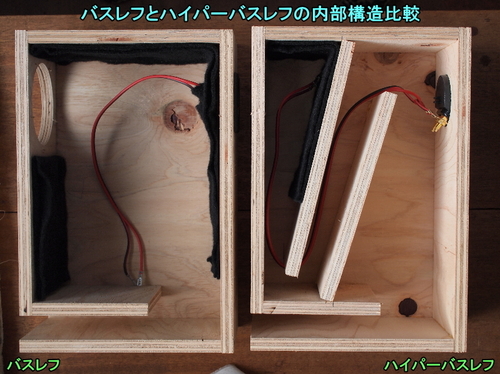
Google translate says:
Features of the hyper bass-reflex system
① The sound vector (directionality) is located between the bass reflex system and the back load system ② The complex motion type has a simple structure and can be made relatively small ③ By adopting the back load element in the bass reflex system, Bass reflex of the same size can be efficiently drawn ④ The same size bass reflex, it can not be obtained with a sealed sound, it can produce a sense of scale ⑤ Because it is suppressing the movement of the cone by multiplying the hybrid braking, the power enters ⑥ Two partition boards Is entered diagonally, the characteristic aberration and the standing wave are suppressed, and the minimum required sound absorbing material is sufficient
Last edited:
What is "hyper bass reflex"?
End loaded air cavity will act as a low pass filter into a short 2-section expanding pipe, then mass-loaded.
dave
Goodness knows. Depends when they tell other distributors about them, and receive orders for stock.
Re the motor, with an electrical Q of 0.717 and a B*L factor of 3.63 according to the screen shot on Norio's site, I wouldn't personally define it as a 'very, very big magnet'. More in the usual upper middling Q regions per usual for the MA 4in models.
More in the usual upper middling Q regions per usual for the MA 4in models.
Re the motor, with an electrical Q of 0.717 and a B*L factor of 3.63 according to the screen shot on Norio's site, I wouldn't personally define it as a 'very, very big magnet'.
Member
Joined 2009
Paid Member
What is "hyper bass reflex"? The second design.

Google translate says:
Features of the hyper bass-reflex system
① The sound vector (directionality) is located between the bass reflex system and the back load system ② The complex motion type has a simple structure and can be made relatively small ③ By adopting the back load element in the bass reflex system, Bass reflex of the same size can be efficiently drawn ④ The same size bass reflex, it can not be obtained with a sealed sound, it can produce a sense of scale ⑤ Because it is suppressing the movement of the cone by multiplying the hybrid braking, the power enters ⑥ Two partition boards Is entered diagonally, the characteristic aberration and the standing wave are suppressed, and the minimum required sound absorbing material is sufficient
seems like some kind of MLTL, in ths case an expanding TL.
- Home
- Loudspeakers
- Full Range
- New Markaudio Drivers